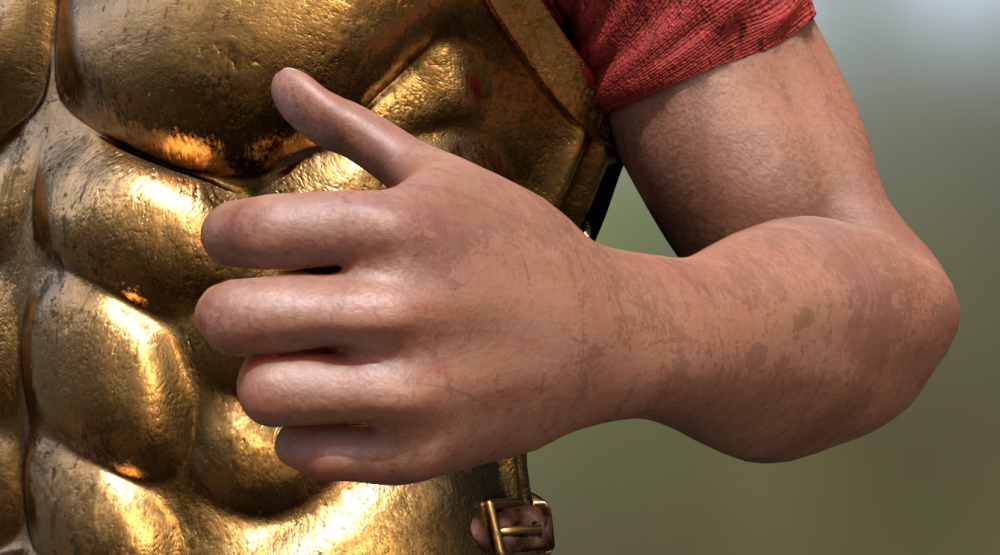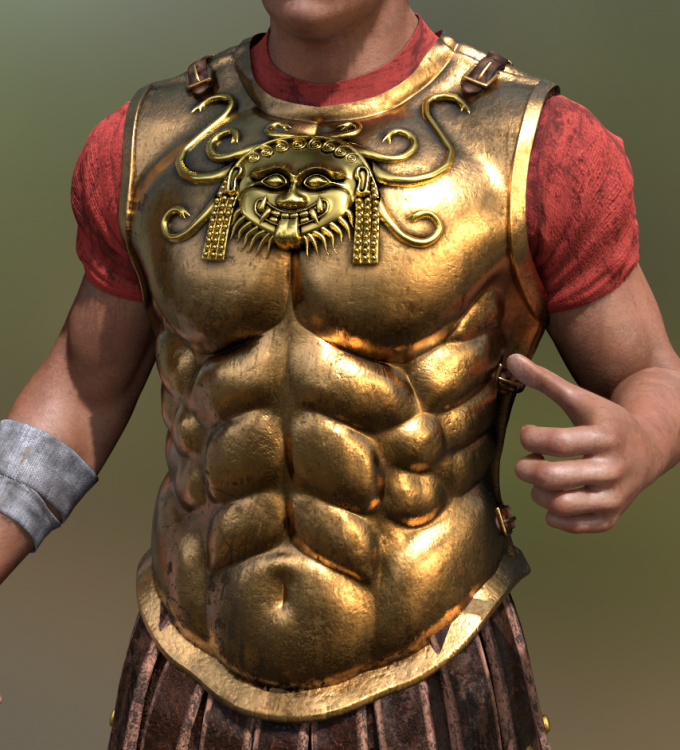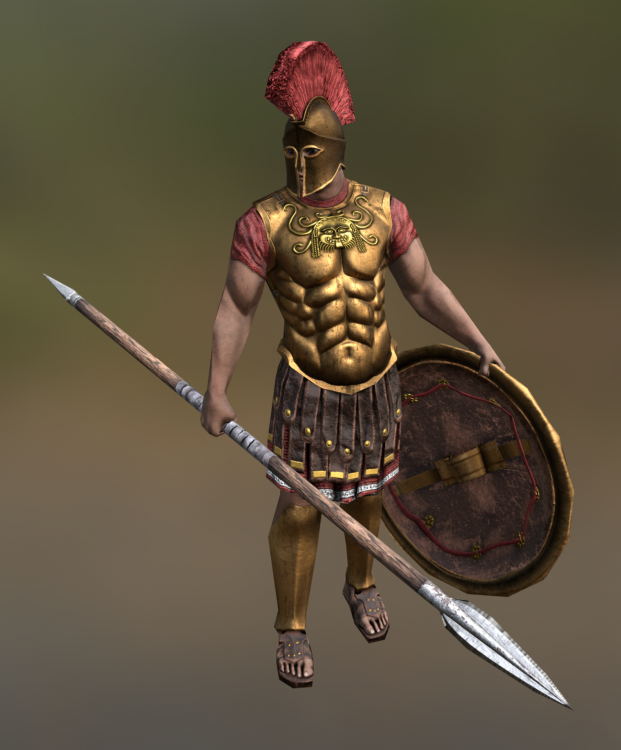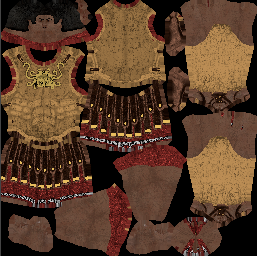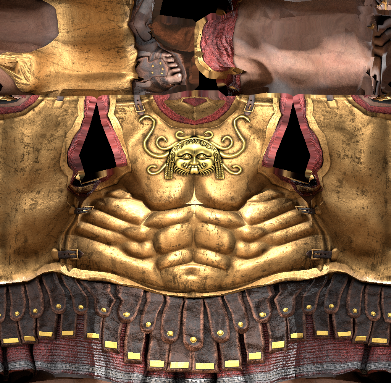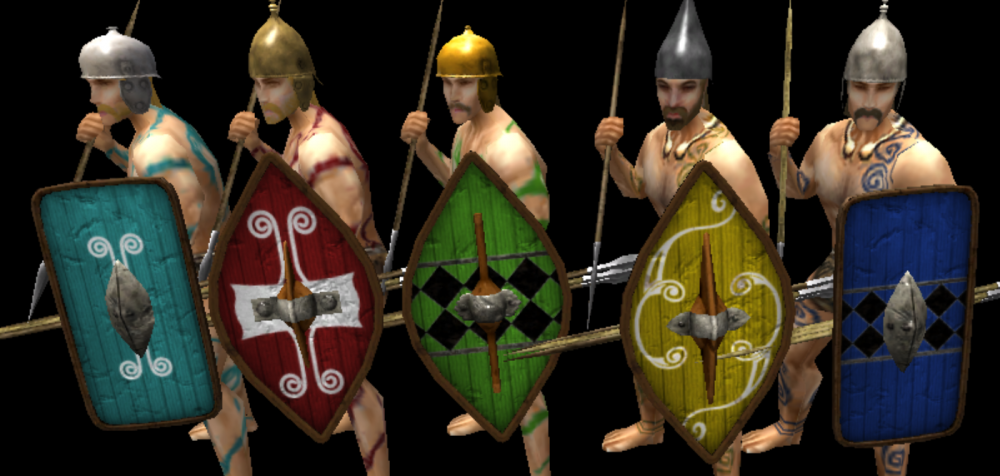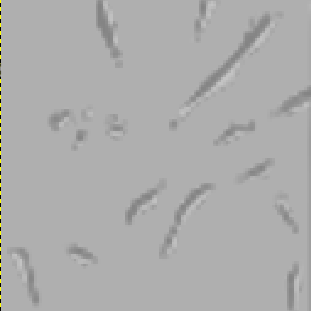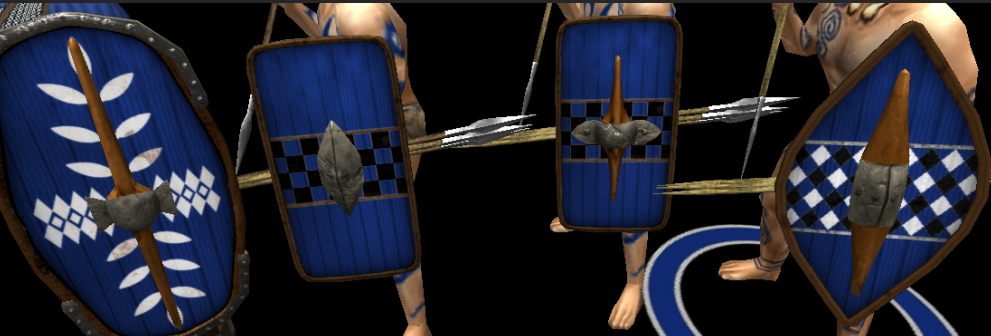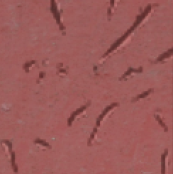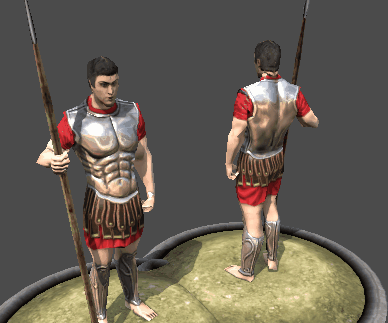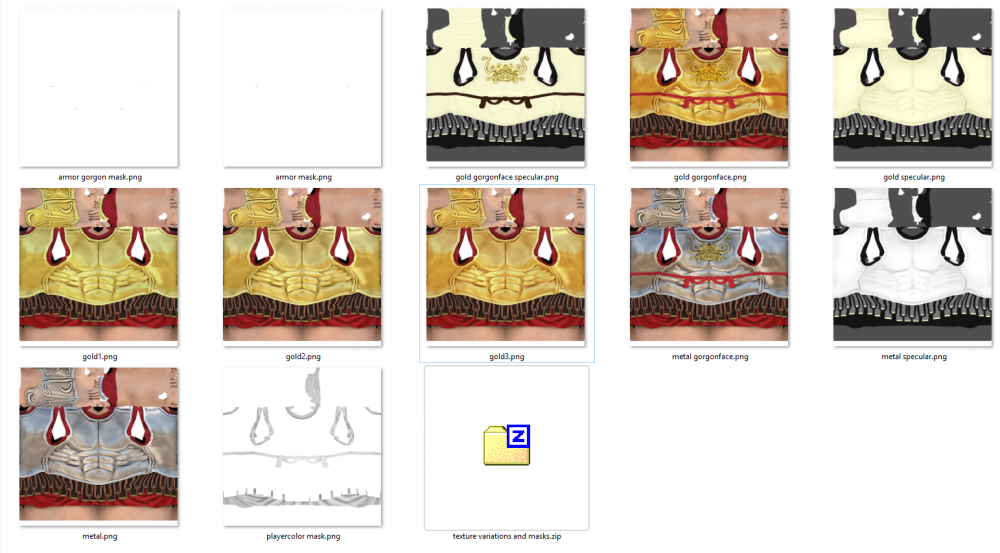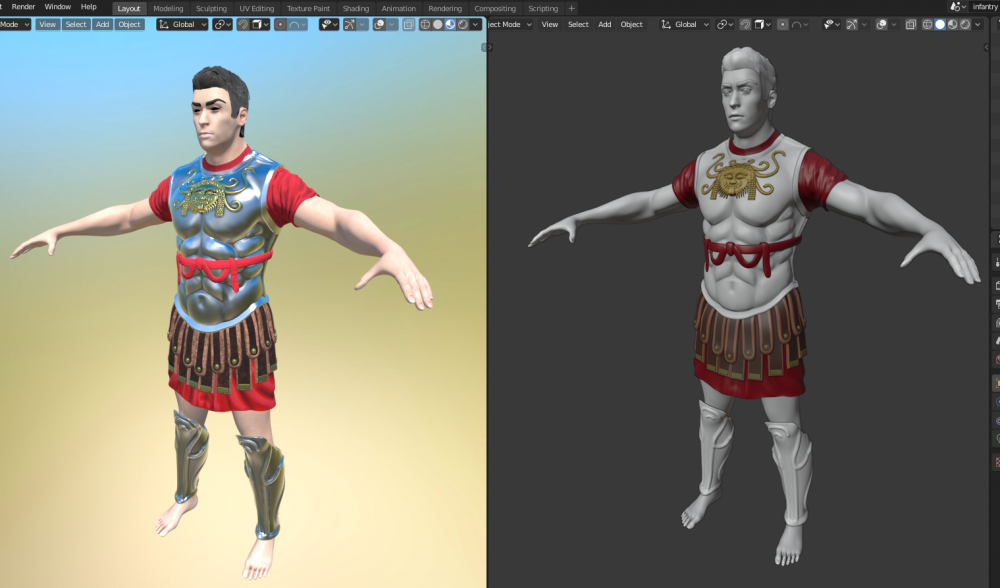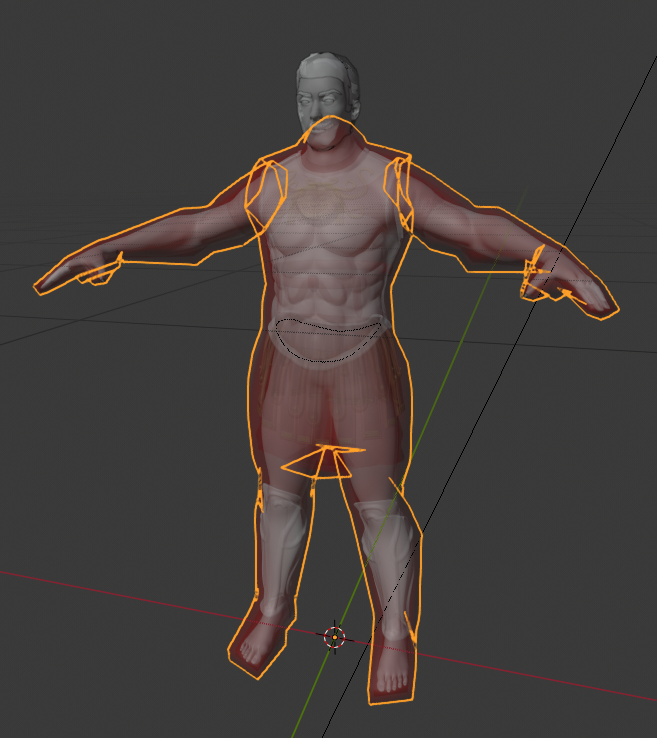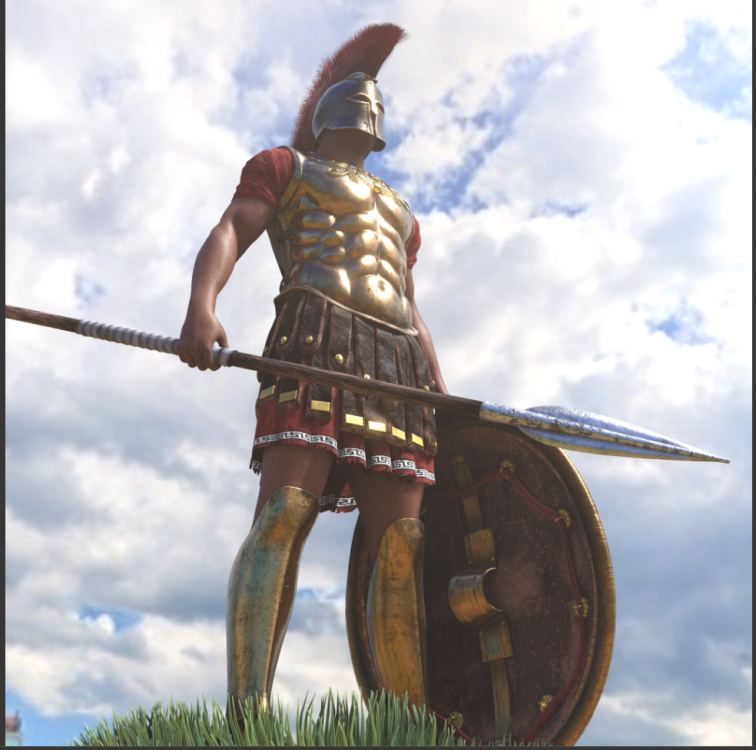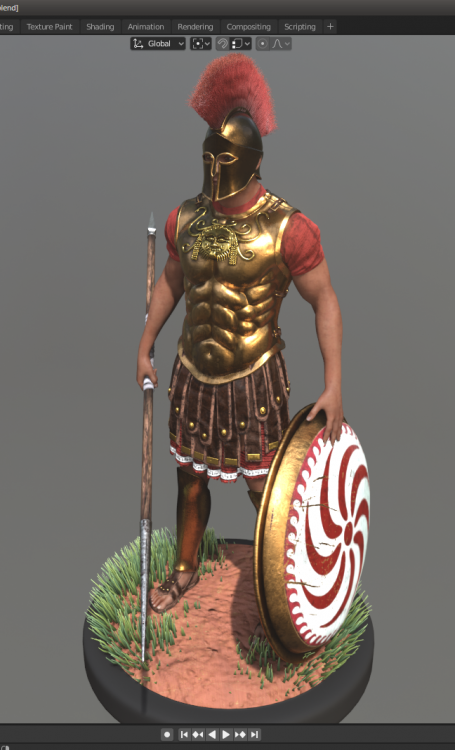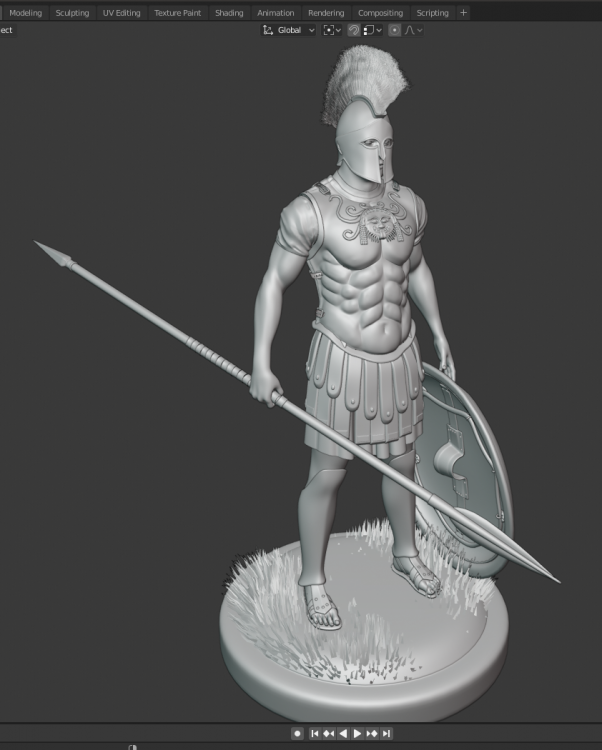
Enrique
WFG Retired-
Posts
2.338 -
Joined
-
Last visited
-
Days Won
96
Everything posted by Enrique
-
The skin is taken from a makehuman model. I just multiplied dirt in top and used a tiling small skin texture to make the pores detail: The metal is a simple color, multiplied with vertex colors, and then the dirt on top. It is pretty simple, but in a PBR engine, the reflections and fresnel makes all the heavy lifting in the shader: Apart from that, I just used a sunlamp in the front, and another without shadows in the back. I just baked it without much more setup to get the result from above. On a more serious test I made a few months ago, the result on a PBR engine with a similar unit mesh as 0AD (1.2k triangles) looks like this (this is with 2k textures though): But the heavy-lifting is done by the engine and PBR visuals. This is the diffuse: So as you can see... the biggest impact in visuals will always reside on the engine and the shaders that is able to pull-off.... not the amount of detail in the texture. If I remember correctly I left somewhere in the forums a high-res version of a guy with this armor? or similar? it is just a matter of creating a setup for baking all the details into a 0AD unit. Both normals, AO, diffuse... Then you can just create hi-poly versions of the units you want to it and bake with the setup.
-
Here's a quick dirty bake from a personal project as an example of detail-is-not-everything. You can test this texture set out hidetail textures.rar on an m_armor_tunic_long and compare in-game (downscaling to 256 first) with the regular zoom option with any other unit that looks similar, and you'll see how little benefit for gameplay visuals these do. Even with much less details than this, some fancy shader effects allowing to see reflections moving when the unit moves is much more impactful than any super-duper-detailed textures you create. Small preview:
-
Yes, but not limited to those. You can also play for recoginition with pose(s) and animations, color scheme, playercolor placement scheme, silhouette, props... The thing is that I always see that historic autenticity always wins in these forums against the gameplay/readability. May work on some cases, but can hurt gameplay / game experience for sure. That's why unit visual design is a very complex and important area in zoomed out / isometric RTS that usually have behind several concept art studies and tend to sacrifice historic accuracy in benefit of clarity and readability. There are other solutions that can alleviate the hard choices that have to be made on unit visual design... a good example are the banners with specific and easy to read unit types of the batallions on Total War series which allow them to make units that you have to zoom in to see differences between them, but it is clear when you zoom out and see the banners.
-
It would be so much easier for artists to create quality content, since with just a simple diffuse and a strong-ish normalmap would take care completely of metallic surfaces. If you can have a mask or simply the AO map to take care of where reflections should be stronger and where they shouldn't, even better. Furthermore, this feature was already tested and is written already since a lot of time and it was used in a mod! https://wildfiregames.com/forum/index.php?showtopic=19650&p=304957 Imagine if this was already implemented, with all the updates to units and textures you guys did recently, if you would be able to take advantage of reflections while doing them.... Specially since you guys are aiming for such fidelity when zooming in... Seems that people on the forum forgets about this being a rts meant to be played with zoomed-out camera, but always the screenshots and designs of the units are focused on zoomed-in perspective, which can lead to harder unit recognition from afar. In any case, with the amount of art content already in the game, the biggest improvements in art resides in shaders/engine, instead of manually having to redo and keep up-to-date units textures with the passing of the years... SSAO, cubemaps, detailmaps, tiling... Then it would be really worth it to redo things taking advantage of new features. (Great to see the recent additions of soft shadows for example) This is still relevant I think:
-
Awesome job @Alexandermb If you want to keep pushing it forward, try bothering a dev to implement fake reflections (cubemaps) as an "add" layer to the metal shader and a slider or a way to set up its strength. Metals will look 200% better.
-
===[TASK]=== WONDER: Persians: Apadana of Darius
Enrique replied to Mythos_Ruler's topic in Official tasks
Oh man... I can't believe after 6 years this isn't in the game even as a editor building. -
Age of Empires 2 Definitive Edition
Enrique replied to Lion.Kanzen's topic in Introductions & Off-Topic Discussion
Age2 DE showmatches starting in a minute here: https://www.twitch.tv/escapeaoe Not sure if they'll be uploaded to yt after stream is finished. Enjoy! -
You'll see many empty vertex groups for bones that don't deform because the engine will complain about those bones not being recognized when getting the armature ingame. And probably why the duplucated vertex groups originated. Regarding poses... I'd agree with @wowgetoffyourcellphone, I think a cleaner and easier to read pose is more beneficial than a 100% acurrate one, specially if it impacts the shilouette and intention of the pose negatively Specially when you aren't even able to zoom ingame enough to see if the shield floats, or if it actually have the correct hand-grips etc
-
1- bake the physics animation 2- Scroll through the timeline with the bones you want to keyframe selected 3- Insert keyframes for all bones selected using "visual loc-rot" each frame or each 2 frames (depending how much fidelity you want) 4- Save the animation in the dopesheet and append it from a blendfile without the physics setup and see the result. 5- Profit
-
Speaking from the lack of knowledge from the latest animation additions, wouldn't be higher priority to make more death variations for infantry units? Afaik, I just made one on the original animation set and I don't really know if any other death variations were added later on. On the same train of thought, it could be interesting to apply the same changes done lately to the armature in the blendfile with the ragdoll setup to make such animations based on physics (bake the animation and keyframe required bones by inserting "visual loc-rot" keyframe. (I would make a test first keyframing all bones and if the animation look weird, leave out the root bone from the keyframing bone set)
-
The original idea behind the different walk/jog/run was to having the game decide which animation play based on the current unit speed (also thought that in the future with batallions unit may have the need of acceleration/exhausted mechanic and this would help with the different speeds transitions) And the purpose of relax/ready animation variants was in the case that the units could became aware of enemies being close and change their animations to the "ready" variants dinamically, so they would behave more realistically
-
Oh wow, 30 mins without an admin logged into the forums to delete 3 spam threads. Let's start a thread about it instead of reporting the content so the admins have a notification to delete them. Sigh. Good job ethanray94
-
Looking amazing! Great work! Do you mind sharing some wireframes of the shield mesh?
-
I don't know the ranges you're working on in terms of polycount numbers now, but ~350 tris for a shield prop seems to high imo. (unit body mesh has ~750) Either way, programmers are who should know better to put contraints on art assets. The texturing work on these new props is good, so you don't have to rely so much on polygons to make it look good. This also relates with the texel density (texture resolution based on area covered by the texture) of the new shield/props you guys are making compared with the body unit textures. Here's an example of how crisp and detailed the new shields look compared with the skin/tatoos/heads of the unit textures: If you want to alleviate the disparity between texel density without decreasing resolution of new props, you may try scaling up unit textures accordingly using software that uses AI when scaling up images to enhace details that is getting so popular to remaster old games textures and such. Here's an article with examples: https://petapixel.com/2017/10/31/website-uses-ai-enhance-photo-csi-style/ I think it is worth if you don't want to manually enhace all unit textures ingame. At least doing some tests to compare. Cheers!
-
Perhaps an overlay layer for the new shields you guys are making should have some hack damge. Something like this (which was used to make other shields in the game): These shields you make look awesome, but the wood parts are in pristine condition (and the middle part has damage):
-
===[COMMITTED]=== Scythian Archer - Athens (Rework)
Enrique replied to wackyserious's topic in Completed Art Tasks
Adding the wicker texture in the inner part of the curved shield of the back will help the unit silhouette to pop more since now they're almost the same color -
Deforestation - Wood should be a renwable resource
Enrique replied to balduin's topic in Gameplay Discussion
Man.... resource scarcity is one of the most important strategy factors in aoe-like rts. For better or worse 0AD is an RTS game, not a citybuilder. It may sound harsh, but decisions like this should be towards benefitting the strategy part, not pretty city-builder game. I'm ok if the idea is to make a toggle option, but don't make it default. Denying the access of a scarce resource in a map to your enemy is a strategy that you'll simply erase or greatly diminish by making resources regenerate, and also lower the ability cap imho. Adapting to the map that you're playing on is totally dependant on how good you're able to manage your available resources, and plan your strategy accordingly. Things like corrals are different since you have to invest in generating animals for the boost in food in the future, BUT you have to make that decision and plan accordingly. Mindlessly harvesting the resources in the map without caring since they'll be infinite is just removing a core part of an rts with resource management.- 105 replies
-
- 5
-

-

-
- feature
- suggestion
-
(and 3 more)
Tagged with:
-
While I like the variations of shaggy pants and the suggestion of more head variety, I don't think props that require the unit armature for deforming like the linothorax is a good idea since I think they spawn a whole new instance of the armature and very small number of bones are used, a lot of computations of the rest of the bones is wasted. I'm ok for things like greaves, which a simple prop-bone in the armature that already uses the base-unit is enough and needs no deformation. Also linothorax is such a small difference and can be already be done via textures, so I don't think it is worth. The only separated prop that I made with animation that uses the unit armature are the capes, which were too important to leave them out. My opinion would be that if you want animated props that make substantial changes in the unit silhouette then make a new variation of the whole unit mesh, which I think it is less resource heavy than the approach mentioned above.
-
If you guys really want to push the visuals further for metals without having to re-create every texture and having to bake from highpoly, you should actually implement this: This is how reflections were faked before PBR in games (and it is still used). IIRC the reason not to implement it was due to "reflections not being accurate enough" which is a bit presumptuous since this technique is actually for faking them. Making the reflected environment texture very generic and quite desaturated will work perfectly for all kinds of metals. And if you want to go even further, wraitii mentioned that the reflections could be affected by fresnel, which is basically all you need to fake the reflections in both dielectric(non-metal) and metal materials. (you could do subtle reflections on marble, vases, rooftiles, whatever) In top of that, the performance hit is very low. Here's how stuff can look with this technique: If any artist want more information this tehcnique, is a nice in-depth tutorial of faking such reflections witha more complex setup on a non-PBR renderer (despite the title) https://www.youtube.com/watch?v=Jb_Xf4SWljs Cheers!
-
Wouldn't make more sense to keep the baked environment fake reflections in the texture, and leave the specular higlights to be done by the actual realtime specular effect that the game offers? (using the textures "bakes with no sun") I haven't seen them tested in-game properly, so my comment is directly based on these textures you posted. Also don't forget to use the whitest possible map as the specularmap. @wowgetoffyourcellphone @wackyserious Here I'm attaching some texture variations (specially gold hues). I also cleaned up the body part texture, which in wow's test screenshot turned out specially dark. Zip contents: texture variations and masks.zip
-
===[COMMITTED]=== Horse Update 2.0 (Retexture)
Enrique replied to Alexandermb's topic in Completed Art Tasks
Went throught the thread and overall very nice work. I know how daunting may be tackling a task so big . My planning for the horse rework that I was working on didn't involve so many texture variations (which by the way your material setup for creating the textures provides a lot of versatility), and definitely didn't plan to do separate meshes for manes (at least not for the initial implementation). So in that sense you really went ahead Another different route I took with my take on it was that I got a bit carried away when I was working on it and developed a setup with ragdolls that controlled the bones to allow me to make very cool death animations with no effort at all... also it was fun as hell !! I think I recorded a video that should be around the forums somewhere lol. I also planned to use the ragdoll setup to record several foot unit deaths variations, not only cavalry (I think I just made one lazy animation for the unit deaths) - The ragdoll setup was so cool that it allowed me to create like "strength amounts" for the joints for the unit props... i.e. : A unit holding a shield was more likely to drop the shield when falling from the horse, since the fall was harder than a unit falling from standing stance. I still have the setup blends (which I think I uploaded?). I hadn't time to download latest 0AD yet... so I haven't checked the horse animations. From texturing point of view they look cool and with a lot of variation. The only nitpicks I'd mention is the horse body being a bit too long - making overall a bit too big compared to the unit size. The other thing I'd mention is that I didn't see any normalmap being applied? or maybe the screenshots didn't show it properly? Either way, pretty solid work -
I have no knowledge of the state of things to know committability of stuff
-
I thought the idea behind baking an all this stuff was to have metallic reflections in the texture to make a more believable metal look Here's the file for the baking setup. I tried packing into the blend all textures. @Alexandermb @Stan` I warn you it is quite poly heavy (+1M polys) (blender 2.7x file) https://we.tl/t-iZj9Gz4110 (one week expiring link) I hope it is useful Cheers!
-
The textures you see on the .rar attached to the first post is all I have. I didn't have it in mind. IMO it is too much work for very little benefit. This is an isometric rts game with zoom option. Players zoom in 1% of their playtime, and in assets such small screen space are much better distinguishable by the handapainted textures you guys have been doing so far. The reason behind this test I made was to check how metallic materials could be improved by faking reflections on the diffuse texture itself. (Focus was the chest armor) The workflow I described on the first post is the basic art pipeline on any standard production that is realtime 3d based on realistic artstyle, nothing I invented at all. You guys can grab makehuman and in few slider tweaks you can have a cool basemesh to dress it for baking as I did, or I could upload the file where I did the bakes for the setup. Bottom line is: I didn't like how metals looked in-game, did some tests on PBR bakes, and realized it was too much work for this approach. Implementing matcaps/cubemaps (which was already semi-implemented by wraiiti quite some time ago) would be the way to go imho
-
Since @wackyserious mentioned he wanted some textures I made a while back as a test, I'll leave them here. I thought originally that they differ a bit from the current artstyle of the game, but if you guys want to push it further, why not. I attached them to the thread. The process I used to get the textures was to model/sculpt high-res meshes, using a human model from makehuman (CC0), then creating PBR materials, and using a "expanded" 0AD mesh as the cage for the baking into the standard unit: This is the model from where it was baked: This below is the "cage mesh" which is just the regular 0AD unit mesh, but expanded to cover all the hi-res model. Then the "real" mesh where it was baked to is in the same pose as the highpoly, and should have exactly the same topology/polycount of the cage. The cage is using when baking to avoid having to deform the standard mesh, and to have a direction in baking rays that would look good on the final mesh: Finally this test was nice, but I thought it was just too much work to re-do all unit textures in this fashion, although as you can imagine, it has the best results: (good AO, perfect normals, much details) which by the way they're a bit innecesary on a RTS game (specially without LODs), even though it looks cool. I must say I followed up a bit this as a personal project to learn about the PBR workflow of blender 2.8 and test the realtime EEVEE engine. Good learning experience: If anyone interested I could upload the blender file with the setup for the baking showed in the first images, although textures and all, it is around 270 MB The textures attached are from the original tests I made, they are in different resolutions and also different render pases, they may be used for achieving different textures if edited too. (Normalmap green channel is already inverted, so it is 0AD-engine ready) Cheers! 0ad unit test hires.rar
- 22 replies
-
- 11
-

-


